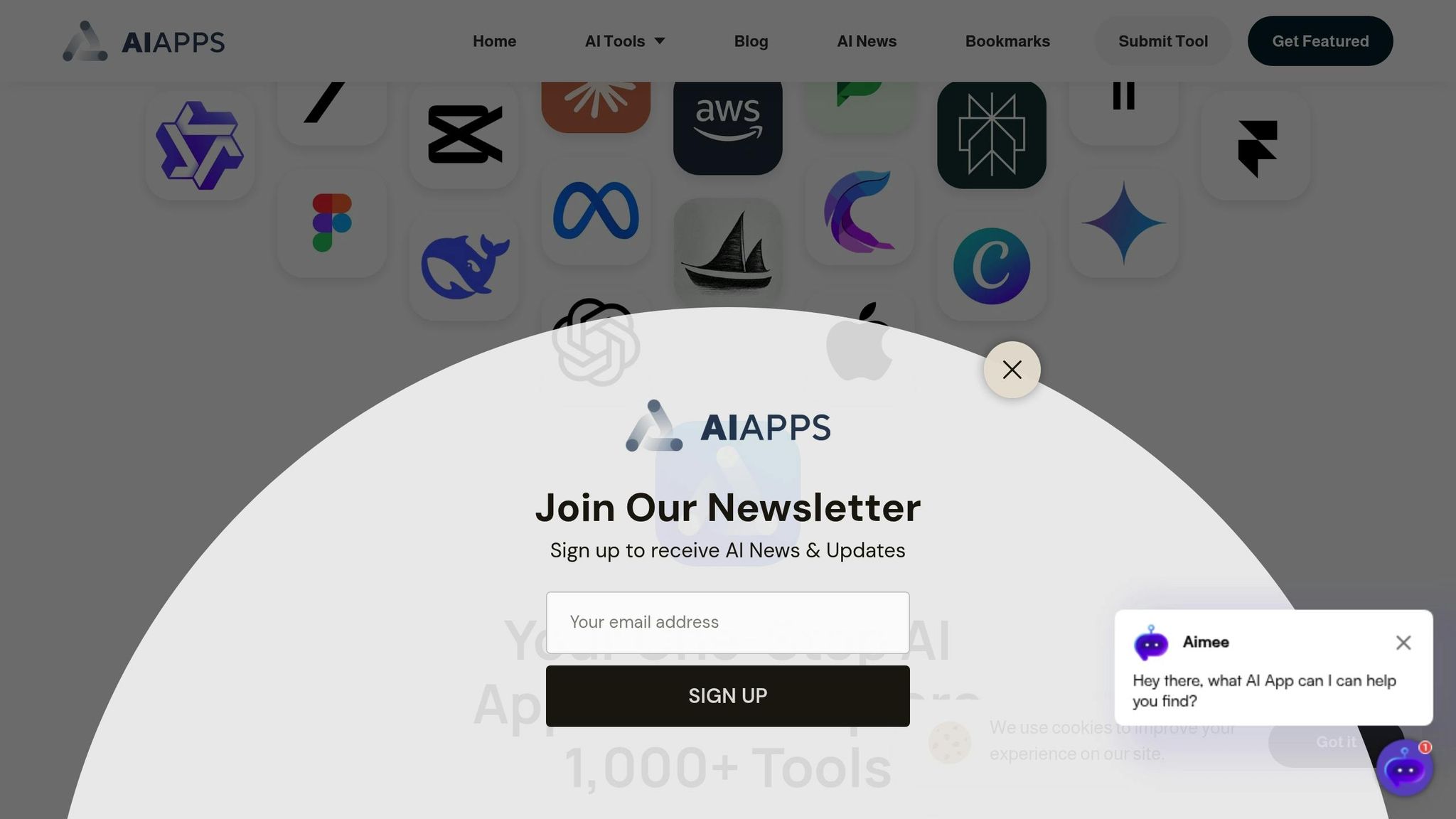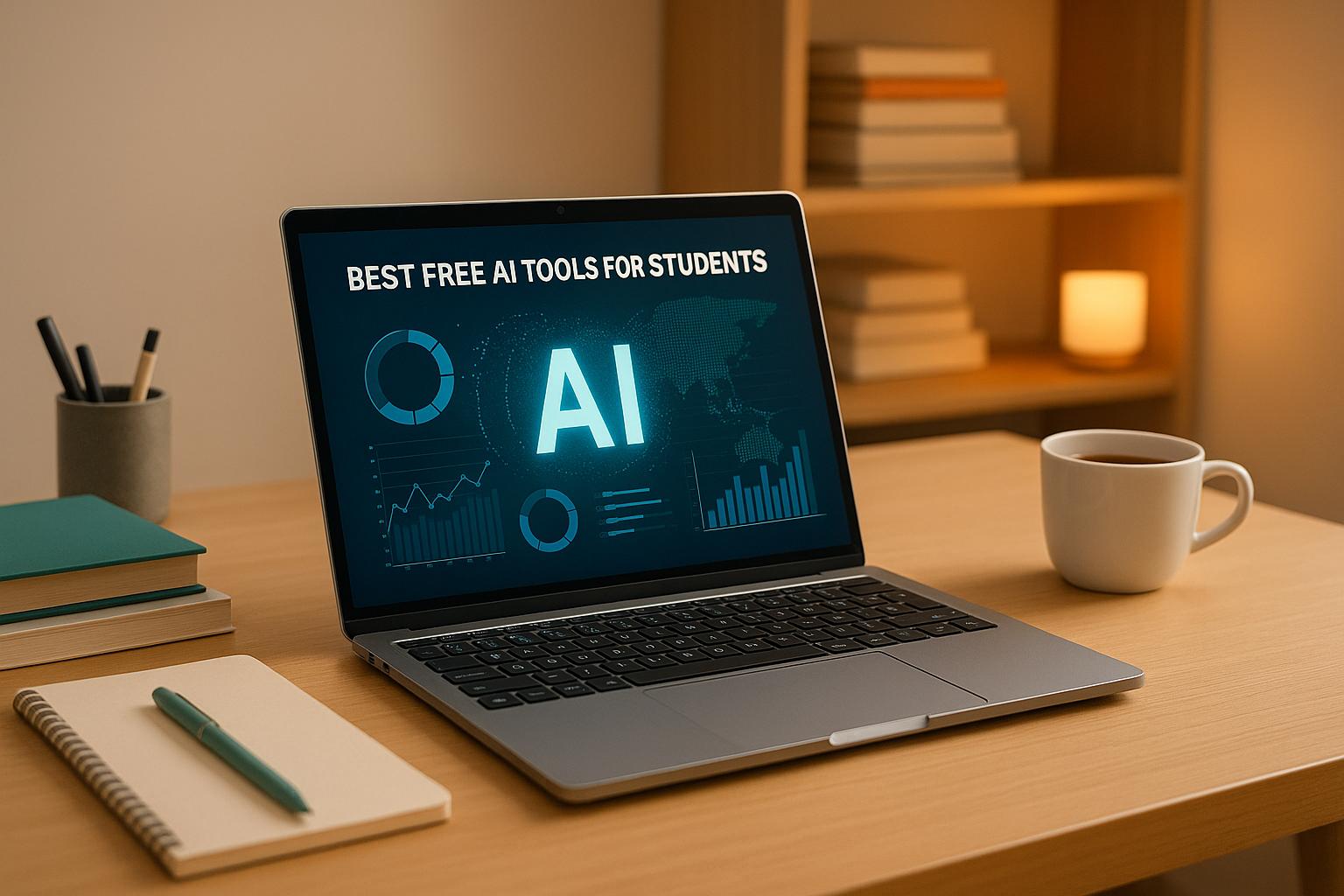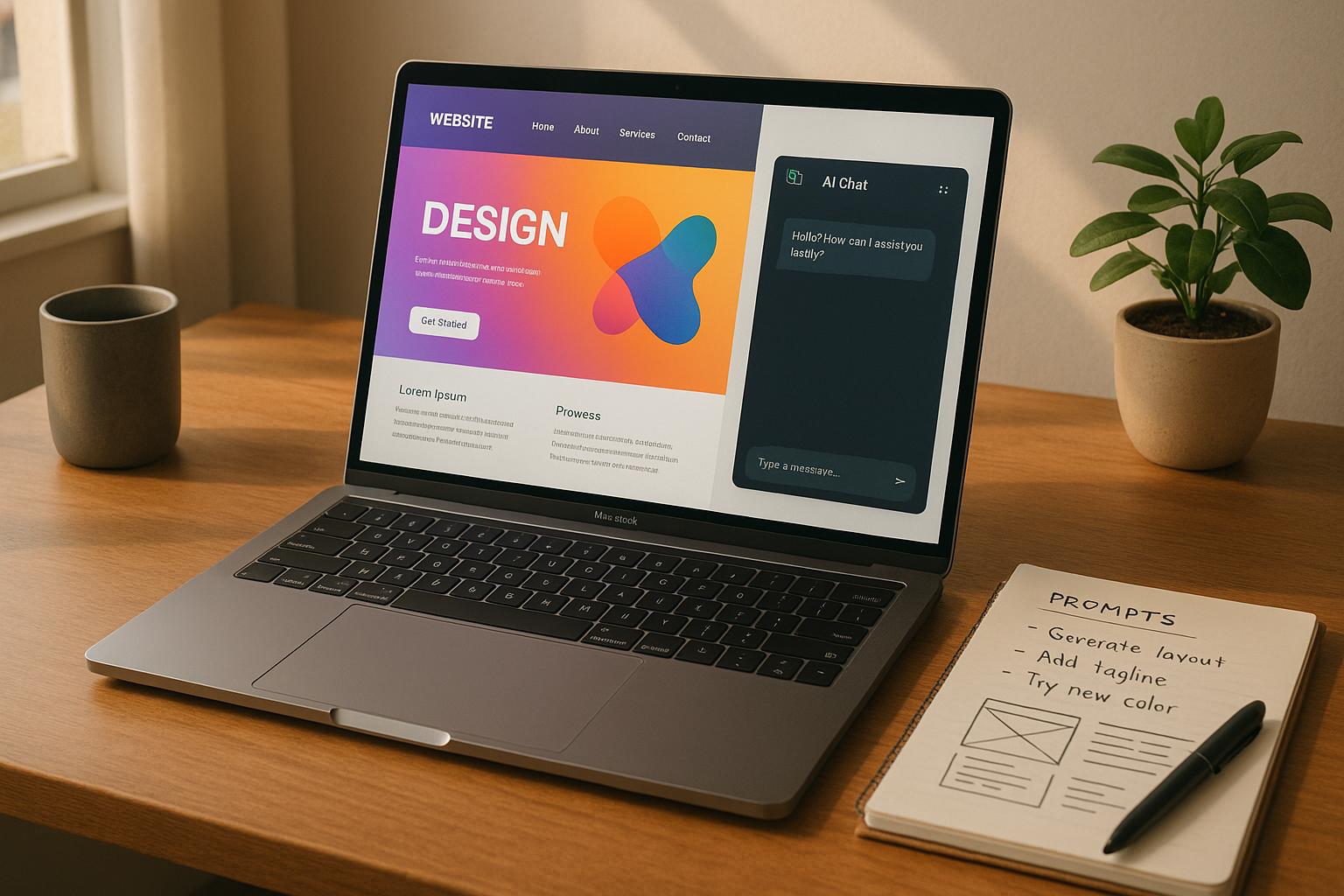AI tools are reshaping how we work in 2025, helping professionals save time, work smarter, and collaborate better. Whether you're in a hybrid office setup or managing remote teams, these tools are designed to optimize productivity and simplify complex tasks. From automating repetitive work to providing data-driven insights, AI is now accessible to businesses of all sizes.
Key Highlights:
- Automation: Tools handle repetitive tasks like scheduling, data entry, and email management.
- Time Management: AI optimizes schedules, tracks productivity, and suggests improvements.
- Collaboration: Streamlined communication tools summarize meetings, assign tasks, and unify team updates.
- Content Creation: AI drafts, edits, and organizes content, saving hours of work.
- Data Insights: Advanced analytics tools simplify decision-making with real-time insights and predictions.
If you're unsure where to start, platforms like AI Apps offer a curated directory of over 1,000 AI tools tailored to specific needs and budgets. Begin small by identifying a single area for improvement - like scheduling or content creation - and test tools that integrate with your existing platforms. Track time saved, quality improvements, and overall ROI to ensure success.
2025 AI Productivity Stack: Top 10 AI Tools I Use Weekly to Get More Done
Main Types of AI Productivity Tools
AI productivity tools are designed to address specific workplace challenges, making tasks easier, faster, and more efficient. By understanding the different types of tools available, you can better match them to your work style and needs. From automating routine tasks to analyzing complex data, these tools play a vital role in boosting productivity. Let’s explore the main categories and how they enhance workplace efficiency.
Task Automation Tools
Task automation tools are all about eliminating repetitive, time-consuming tasks. These AI-powered solutions handle everything from organizing emails and scheduling posts to generating reports and managing data entry. They work seamlessly in the background, learning and improving as they adapt to your workflow.
The best automation tools integrate with the platforms you already use, such as email, calendars, project management software, and communication tools. For instance, they can automatically add calendar events from email invitations, update project statuses as tasks are completed, or send follow-up emails after meetings. They can even manage customer interactions by qualifying leads, updating records, and triggering personalized email campaigns - all of which can save you hours every week.
Time Management and Scheduling Tools
AI scheduling tools are much more than digital calendars - they actively optimize your time. By analyzing your work patterns and scheduling needs, they can block time for focused work, suggest ideal meeting times based on participants’ schedules, and even reschedule appointments if conflicts arise.
These tools shine in hybrid work environments. They take into account commute times, office availability, and team member locations to suggest practical meeting times. Some even book resources and adjust schedules in real time.
The most advanced tools go a step further by tracking how you actually spend your time. They provide insights into productivity patterns and pinpoint areas where time is wasted. This data empowers you to make smarter decisions about your workload and priorities.
Team Communication Tools
AI communication tools are changing the way teams collaborate, especially in remote and distributed workplaces. These tools use natural language processing to summarize lengthy conversations, translate messages instantly, and recommend relevant documents or team members for specific discussions.
They also make meetings more productive. By automatically transcribing and summarizing discussions, extracting action items, and assigning follow-up tasks, these tools ensure nothing falls through the cracks. Some even analyze the tone and engagement levels of conversations, helping managers address potential issues early.
With cross-platform integration, these tools pull information from emails, chat apps, project updates, and documents to provide a unified view of team progress. This reduces the need to switch between multiple platforms, streamlining daily workflows.
Content Creation and Note-Taking Tools
AI content tools have transformed how professionals approach writing and information management. These tools can draft content, refine existing text, summarize meetings, and turn rough notes into polished documents. They’re designed to understand context and tone, tailoring their output to match your style and audience.
Advanced note-taking tools go beyond simple organization. They tag and categorize your notes automatically, suggest related content from past meetings or documents, and even build searchable knowledge bases. Some tools analyze patterns across your notes to generate helpful insights.
Voice-to-text features have also reached impressive levels of accuracy. You can dictate ideas, meeting notes, or even detailed documents, and these tools will format and structure the text appropriately. They can even identify different speakers in a meeting and offer suggestions for improving clarity and readability.
Data Analysis and Decision Tools
AI data tools make complex analytics accessible to everyone, even those without technical expertise. They can identify trends, predict outcomes, and recommend actionable steps based on your data. Visualizing data becomes easier, allowing you to make informed decisions quickly.
Business intelligence tools powered by AI monitor key metrics in real time, alerting you to changes or opportunities. They analyze customer behavior, sales patterns, and market trends, helping you stay ahead of the curve. With natural language processing, you can ask questions in plain English and get instant, accurate answers.
Predictive analytics features help you anticipate challenges and opportunities. These tools can forecast sales, flag potential customer churn, and recommend how to allocate resources based on historical data and current trends.
For those looking to explore these tools further, AI Apps offers a platform with over 1,000 curated AI tools. It’s an excellent resource for finding solutions tailored to your productivity needs and budget.
AI Apps: Your Hub for AI Productivity Tools

AI Apps is your go-to platform for discovering over 1,000 carefully selected AI tools designed to supercharge workplace productivity. By organizing tools into clear categories and offering advanced search options, AI Apps simplifies the process of finding the perfect solution for your needs.
What AI Apps Brings to the Table
AI Apps acts as a well-organized directory, categorizing tools into groups like AI Text Generators, Video Tools, Art Generators, and various automation solutions.
With advanced filters, you can narrow down your search by category, sub-category, or pricing model, helping you find exactly what you're looking for. The platform also highlights featured tools and newly launched applications, so you’re always aware of the latest advancements in productivity tech. By curating solutions that address common workplace challenges, AI Apps saves you the hassle of extensive research and trial-and-error testing.
Pricing and Listing Options
AI Apps makes it easy for developers to showcase their tools while keeping the platform accessible for users. The pricing structure includes a free listing option, ensuring that basic information about tools is available at no cost. For developers seeking extra visibility, paid featured listings offer premium benefits.
| Listing Type | Price | Features | Benefits |
|---|---|---|---|
| Free Listing | $0 | Basic tool information and inclusion in the searchable directory | Access to the full directory and user reviews |
| Featured Listing | Paid | Premium placement, homepage visibility, and category top spots | Greater visibility and priority positioning across the platform |
Featured listings are ideal for developers aiming to stand out. These listings provide premium placement on the homepage, top spots in relevant categories, and an enhanced visual presentation, ensuring that quality tools get the attention they deserve.
Tailored for US Professionals
AI Apps is built with a focus on the needs of US-based professionals. It incorporates American business standards and formatting conventions, making it easy to navigate and understand.
- Pricing is displayed in US dollars ($).
- Dates follow the MM/DD/YYYY format.
- Numerical data uses commas for thousands and periods for decimals.
- Time-sensitive details like tool launch dates and updates are shown in a 12-hour clock format with AM/PM indicators.
This thoughtful design ensures that American users can quickly interpret and evaluate tool information without confusion, streamlining their productivity journey.
sbb-itb-212c9ea
How to Add AI Tools to Your Workflow
Adding AI tools to your workflow can streamline operations, but it’s important to approach the process thoughtfully. Start small, test thoroughly, and expand based on results.
Step-by-Step Setup Process
Begin by auditing your current workflow. Identify repetitive tasks, how long they take, and who handles them. This helps pinpoint areas where AI could make the biggest impact.
Focus on one category at a time. For example, if managing emails is your team’s biggest challenge, start with AI email assistants before tackling other areas. This targeted approach allows your team to master one tool without feeling overwhelmed.
Run a 30-day pilot program with a small group of tech-savvy team members (3-5 people). Track metrics like time saved, error rates, and overall satisfaction to gauge the tool’s effectiveness.
Ensure compatibility with your existing platforms - such as Microsoft Office 365, Google Workspace, Slack, or Salesforce - during your trial. Smooth integration makes adoption easier and prevents disruptions.
Document clear, step-by-step instructions and troubleshooting tips for the tool. This will make training new team members much easier and reduce confusion.
During the first 90 days, schedule weekly 15-minute check-ins to address any issues. Tackling concerns early can significantly boost adoption rates. Once the tool is fully integrated, focus on measuring its return on investment (ROI).
Data Privacy and Security
When introducing AI tools, safeguarding data privacy and security is critical. Start by reviewing the vendor’s privacy policies to understand how they handle data storage, processing, and training. Many enterprise-grade tools allow users to opt out of data training programs.
Check compliance with U.S. regulations like HIPAA (for healthcare), SOX (for publicly traded companies), and state laws like the California Consumer Privacy Act (CCPA). Request compliance documentation from vendors and have your legal team review the terms of service.
Use role-based access controls and single sign-on (SSO) solutions to limit access based on job roles. Assign different permission levels depending on the sensitivity of the data being handled.
Create clear data retention policies. Decide how long AI tools should store your data and ensure you can retrieve or delete it when necessary. Many tools offer data export options to meet "right-to-be-forgotten" requirements.
Monitor usage patterns with your IT security systems. Set up alerts for unusual activity, such as large data transfers or access attempts from unexpected locations. Regular security audits can help identify vulnerabilities and maintain compliance.
Train your team on secure AI usage. This includes best practices like strong password management, recognizing phishing attempts, and understanding which types of data should or shouldn’t be processed through AI tools. Clear guidelines help minimize risks and ensure proper use.
Once security measures are in place, you can focus on evaluating the tool’s performance and the benefits it brings to your organization.
Measuring Your AI Tool ROI
To measure ROI effectively, start by tracking time savings. For example, if creating social media content used to take 8 hours and now takes 3, that’s a clear metric of improvement.
Monitor key productivity metrics like qualified leads, closed deals, response times, and satisfaction scores. Document these improvements on a monthly basis to track progress and identify trends.
Keep an eye on subscription costs and compare them to the benefits. Use a simple spreadsheet to log monthly expenses alongside measurable gains, such as time saved or revenue generated. This transparency makes it easier to justify continued investment in AI tools.
Evaluate quality improvements in addition to speed. For instance, if AI proofreading tools cut editing time by 40% and reduce errors by 75%, both factors contribute to ROI. Improved quality often leads to fewer reworks and happier customers.
Don’t overlook indirect benefits like higher employee satisfaction, reduced overtime, and stronger competitive positioning. While harder to quantify, these factors add long-term value to your business.
Set up regular reporting schedules - monthly reports work well for most organizations. These should include both quantitative data (like time savings and revenue growth) and qualitative feedback from users. Together, they provide a comprehensive view of the tool’s impact on your workflow.
Conclusion: AI Tools for Better Work Productivity
In 2025, embracing AI tools isn't just an option - it's a necessity for staying efficient and competitive. These technologies simplify workflows, save time, and deliver measurable results. Here's a quick breakdown of the key takeaways and actionable strategies.
Key Highlights
- AI tools provide immediate, measurable benefits in various work areas, improving both the quality and quantity of output.
- Companies experience significant time savings and a quick return on investment, signaling a major shift in workplace dynamics.
- Modern AI solutions come with strong security measures, making them a safe choice for even the most cautious organizations.
- Success hinges on strategic implementation. Starting small - like piloting one tool category - ensures a smoother rollout and better adoption rates.
AI Apps is an invaluable resource for navigating this landscape. With over 1,000 curated tools across multiple categories, it simplifies the process of finding the right solutions. Its advanced filters help you match tools to your specific needs, budget, and technical setup, eliminating the guesswork.
Steps to Get Started
To make the most of these insights, start by identifying your biggest productivity challenge. Whether it's managing emails, streamlining scheduling, or tackling content creation, focus on mastering one category of AI tools before branching out. Use AI Apps to explore options tailored to your needs, leveraging its filtering system to zero in on the best fit.
Begin with a pilot program involving a small, focused team. Choose tools that integrate well with existing platforms like Microsoft 365, Google Workspace, or Salesforce. Track early results - both in efficiency gains and user satisfaction - to build a strong case for broader adoption.
Regularly monitor progress by reviewing metrics like time saved and employee feedback. These insights will guide your next steps, helping you expand your AI strategy with confidence.
FAQs
How do AI tools improve productivity in hybrid work environments?
AI tools are transforming hybrid work environments by taking over time-consuming, repetitive tasks, freeing up employees to concentrate on higher-value responsibilities. They also enhance communication and teamwork, ensuring that collaboration flows smoothly, whether colleagues are in the office or working remotely.
With features like AI-driven virtual assistants and real-time language translation, these tools make workflows more efficient and keep teams connected. Designed to fit into flexible work arrangements, they help maintain productivity and engagement regardless of where team members are based.
How can I seamlessly integrate AI tools into my workflow without disrupting productivity?
To bring AI tools into your workflow effectively, begin with a focused approach. Test them out on a single project or specific task. This way, you can gauge their effectiveness without disrupting your entire operation, giving your team time to adapt without feeling overwhelmed.
Equally important is clear communication and proper training. Make sure your team knows why these tools are being introduced, what benefits they bring, and how to use them. A step-by-step rollout combined with regular feedback will help ease the transition, keeping productivity on track while everyone gets comfortable with the new tools.
What steps can businesses take to protect data privacy and security when using AI tools for productivity?
Protecting Data Privacy and Security with AI Tools
When using AI productivity tools, safeguarding data privacy and security should be a top priority. Businesses can take proactive steps by implementing AI-focused security measures such as threat detection systems and automated compliance tools. These tools help monitor potential vulnerabilities and ensure that AI systems operate within safe boundaries.
Another essential practice is maintaining detailed records of how data is collected, processed, and used by AI systems. This transparency not only builds trust but also ensures accountability when handling sensitive information.
Staying informed about state and federal regulations related to AI and data privacy is equally important. Compliance with these laws helps protect sensitive data and keeps businesses on the right side of legal requirements. On top of that, regular employee training on secure AI usage and enforcing strong access controls can significantly reduce security risks.



